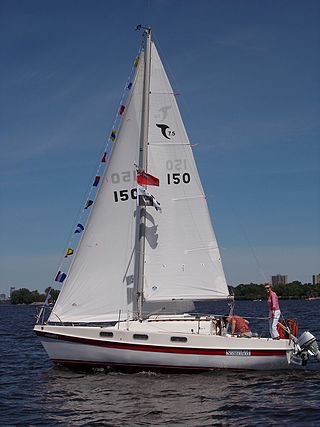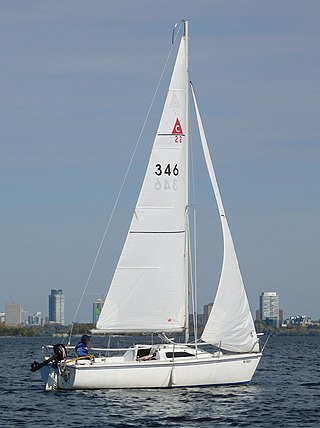
The Hunter 23 is an American trailerable sailboat, that was designed by Hunter Marine and first built in 1985.

The US Yachts US 22 is an American trailerable sailboat, that was designed by Gary Mull and first built in 1979.

The Tanzer 7.5 is a Canadian trailerable sailboat, that was designed by Johann Tanzer and first built in 1977. The design went out of production in 1985.

The Tanzer 25 is a Canadian trailerable sailboat, that was designed by the French company of Joubert-Nivelt and first built in 1986. The design is out of production.

The Capri 22 is an American trailerable sailboat, that was designed by Gary Mull and Frank Butler and first built in 1984.

The Kelt 7.6 is a French trailerable sailboat, that was designed by Jean Berret and first built in 1980.
The Hunter 25 is an American trailerable sailboat, designed by John Cherubini and Bob Seidelmann and first built in 1972.

The Catalina 25 is an American trailerable sailboat, that was designed by Frank Butler and first built in 1978.

The Catalina 250 is an American trailerable sailboat, that was designed by the Catalina Design Team and first built in 1995.
The Hunter 18.5 is an American trailerable sailboat that was designed by the Hunter Design Team as a cruising sailboat and first built in 1987.
The Hunter 212 is an American trailerable sailboat that was designed by Chuck Burns as a day sailer and cruiser and first built in 1996.
The Hunter 22 is an American trailerable sailboat that was designed by the Hunter Design Team and first built in 1981.
The Pearson Electra is an American trailerable sailboat that was designed by Carl Alberg as a Midget Ocean Racing Club (MORC) racer and first built in 1960.
The Capri 25 is an American trailerable sailboat that was designed by Frank Butler as a one design racer and first built in 1980.

The Bombardier 7.6 is a Canadian sailboat that was designed by Ron Holland as a racer and first built in 1980.
The Com-Pac 25 is an American trailerable sailboat that was designed as a cruiser.

The Hunter 25-2, sometimes referred to as the Hunter 25-2005 or the Hunter 25 Mark III, is an American trailerable sailboat that was designed by Glenn Henderson as a cruiser and first built in 2005.
The Capri 16, also called the Catalina 16, is an American trailerable sailboat that was designed by Frank W. Butler as a pocket cruiser and first built in 1987.
The Capri 26 is an American trailerable sailboat that was designed by Frank W. Butler and Gerry Douglas as a cruiser-racer and first built in 1990.
The Neptune 24 is an American trailerable sailboat that was designed as a cruiser and first built in 1978.












